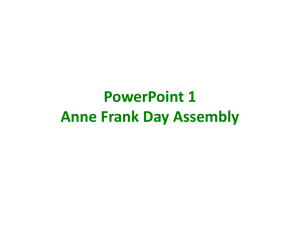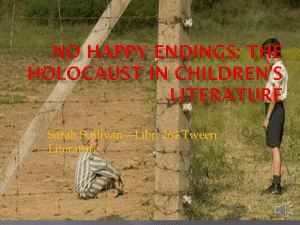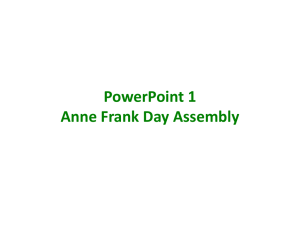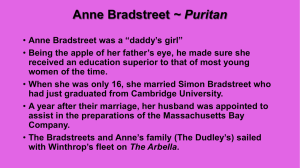The Diary of Anne Frank (the play)
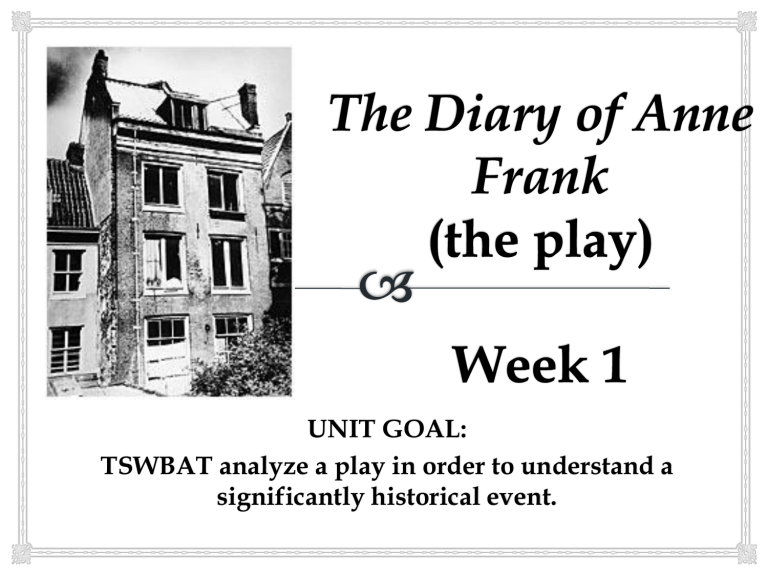
UNIT GOAL:
TSWBAT analyze a play in order to understand a significantly historical event.
Bellwork: Monday,
12/2/13
Take out a sheet of paper and head it appropriately.
Title it “Holocaust KWL Chart & Notes.”
DRAW A KWL CHART.
Under the “K,” write 3 things you know about the
Holocaust.
Under the “W,” write 3 things you want to know about the Holocaust.
Notes on the Holocaust & the play
The play is based on the novel, "Diary of a Young
Girl," published in 1947.
Anne's Diary begins in
1942. Anne is 13 years old-3 weeks before she goes into hiding.
Germany, WWII (1938-
1945)
Hitler ruled Germany
1933-1945
Allied powers (U.S., U.K.,
France, and Soviet
Union) vs. Axis Powers
(Germany, Italy, Japan)
Notes on the Holocaust and the play
Holocaust: Germany's deliberate attempt, under Hitler's rule, to exterminate all Jews in Europe...
Killed over 6 million Jews.
Weapons: Starvation, Torture,
Dehumanization...
Hitler wanted to rid Germany of everyone not of the Aryan race (blond hair, blue eyes)
Notes on the
Holocaust and the play
SS = Hitler's personal elite body guards, did
most of killings ordered by Hitler
Gestapo = Branch of the SS
Star of David: symbol of Jewish Faith
Nazi = Anti-Jew
Swastika = Nazi symbol
“Remembering Anne
Frank…” by Anonymous
unit5/remembering_annefrank.pdf
1. What is a Nazi?
2. What Religion are Anne and her family?
3. List the members of Anne's family. (Mother, father, sister)
4. List three rights Hitler took away from Jews in Germany.
5. What outward symbol(s) were Jews required to display?
6. How old was Anne when she began her diary?
Questions from the article, continued:
8. Why did the Franks go into hiding? Where did they go?
9. Who is MIEP? How did she risk her life for the Franks?
10. How long were the Franks in hiding?
11. When, where, and how did Anne die?
12. Who was the only occupant to survive concentration camps?
13. What did he do after the war to make Anne famous?
14. When and how did Hitler die?
15. List an interesting fact about the publication of Kitty.
16. What was the final outcome of WWII for Jews? (# of losses, etc.)
Review/Closure:
Monday, 12/2/13
Explanation of Unit
Portfolio Checklist & Grading Rubric
Homework Assignment:
Complete reading the article and answer the questions.
Bellwork: Tuesday, 12/3/13
1.
Take out a sheet of paper, head it correctly, and title it “A Tragedy Revealed: A Heroine’s…”
2.
Turn to page 443 in the literature textbook.
3.
Read and answer the QUICKWRITE section.
Quickwrite
If you could interview survivors of the Holocaust who knew Anne Frank, what would you ask them?
Jot down some of your questions.
“A Tragedy Revealed” A Heroine’s Last Days” by Ernst Schnabel (pp. 443-460)
indomitable adj.: unconquerable. Anne Frank’s spirit was indomitable.
annihilation n.: complete destruction. We still mourn the Nazi annihilation of six million Jews.
refuge n.: place of safety. The Franks found refuge for two years in the Secret
Annex.
reconciliations n.: acts of making up after arguments. After the arguments in the Secret Annex came the tearful reconciliations.
inexplicable adj.: incapable of being explained. There were inexplicable sounds coming from the building.
dispirited v. used as adj.: sad and discouraged. The residents were often dispirited during their long confinement in the Secret Annex.
premonition n.: feeling that something bad will happen. When the lamp crashed, the residents of the Secret Annex had a premonition that they would be discovered.
emaciated v. used as adj.: extremely thin, as from starvation or illness.
Anne’s emaciated face showed suffering and hunger.
raucous adj.: loud and rough. They were frightened by the raucous shouting outside the window.
clamorous adj.: loud and demanding. They heard the clamorous voices of the
Gestapo in the stairway.
Page 460 Questions
2. Fill in the L column of your KWL chart. Then, choose one or two interesting facts that you learned, and discuss them with a partner.
3. Choose two quotations from the people Schnabel interviewed, and write the question you think he asked to get each response. Are any of these questions similar to ones you wrote in your Quickwrite notes?
4. This writer wanted to discover what happened to Anne Frank after her arrest. But he certainly had other purposes in writing this factual article. What do you think his purposes were? What would you say is the main idea of the article? Find at least one passage in the article that supports the main idea.
The Diary of Anne Frank
Turn to page 364 in your textbook.
Page 364:
Literary Focus & Reading Skills
Theme: the general idea or insight about human existence that is revealed in a story, poem, or play. It’s what the writer is saying about life.
Resources: maps, timelines, historical photographs, and written entries
Primary Source: firsthand information
Background: Literature and Real Life (pp.
365-366)
Timeline: (pp. 367-368)
Turn to page
370.
Characters:
1. Anne Frank
2. Margot Frank: her older sister
3. Mr. Frank: their father
4. Mrs. Frank: their mother
5. Miep: worker in
Mr. Frank’s business; Dutch
Characters:
6. Peter Van Daan
7. Mr. Van Daan: his father
8. Mrs. Van Daan: his mother
9. Mr. Dussel: a dentist
10. Mr. Kraler: worker in Mr. Frank’s business; Dutch
The Diary of Anne Frank
(the play)
Read Act I, Scenes 1 & 2.
(pages 370-381)
Homework: Tuesday, 12/3/13
Copy the sentences for each vocabulary word from page 444 and pages 364-365.
Study these spelling words and vocabulary terms for tests on Tuesday,
December 17, 2013.
Bellwork: Wednesday, 12/4/13
Take out your portfolios and title a new sheet of paper “Journal Entry #1.”
Read and Answer the following:
Pretend you had one hour to prepare to go into hiding.
You can NEVER return to your home. You cannot carry a suitcase; it would be obvious you were going into hiding. It is winter; therefore, it is VERY cold outside and there is limited food where you are going. What items would you take with you? How would you disguise these items and how would you carry them?
Vocabulary Terms
(The Diary of Anne Frank)
conspicuous adj.: noticeable. The Nazis required all Jews to wear a conspicuous yellow Star of David on their clothing.
unabashed adj.: unembarrassed. Anne’s unabashed comments sometimes embarrassed her mother.
loathe v.: hate. Anne loathed having her mother treat her like a baby.
indignantly adv.: with anger caused by something felt to be unjust.
Anne indignantly claimed she had not been rude.
fortify v.: strengthen. Mr. Dussel took pills to fortify himself.
zeal n.: great enthusiasm; devotion to a cause. The Maccabees showed great zeal in their fight against tyranny.
tyranny n.: cruel and unjust use of power. The Maccabees’ fight against tyranny and oppression two thousand years ago still inspires people today.
Vocabulary Terms, continued
gingerly adv.: cautiously. Peter held Anne’s gift gingerly, afraid it might jump out and hit him.
ostentatiously adv.: in a showy way. Peter held his coat ostentatiously to pretend he was hiding his cat there.
appalled v. used as adj.: horrified. Dussel’s alarming news was met with a moment of appalled silence.
disgruntled v. used as adj.: displeased; annoyed. Mr. Dussel, disgruntled, listened to the conversation.
inarticulate adj.: unable to speak. Peter was so furious at Dussel that he became inarticulate.
forlorn adj.: abandoned and lonely. Dussel felt forlorn when Peter and
Anne both closed their doors on him.
animation n.: liveliness. Anne’s animation could both delight and annoy her family.
remorse n.: deep feeling of guilt. Mrs. Frank felt remorse for her angry outburst.
Vocabulary Review
Kagan
I/O Circle
Mix-Pair-Share
Multiple Intelligence
Activities
Cardstock Activity
(Picture Activity)
MI Body Smart
Activity
Picture/Word Smart
Activity
The Diary of Anne Frank
Read Act I, Scene 3. (pages 381-394)
Homework: Wednesday,
12/4/13
WRITE your spelling/vocabulary terms
(#s1-20 ONLY) 5 times each.
Complete the Reading Check Section (Scenes 1-3).
Use Bubble Maps to describe each of the 10 characters.
“By the end of Scene 3, we have met all ten characters who appear in the play. List those characters, and choose two or three adjectives to describe each one.”
Bellwork: Thursday,
12/5/13
Take out your Character descriptions from homework.
Take out your paper labeled “Journal Entry 1.” Draw a line under your response and title your paper
“Journal Entry 2.”
COPY the following prompt and complete the statement with your own feelings.
After seeing pictures of concentration camps and learning a little about the Holocaust and Anne
Frank, I feel…
Numbered Heads Together page 395
Review of Act I, Scenes 1-3
1. A flashback interrupts a story to take you back to earlier times and events. Most of this play is told in an extended flashback, framed by the opening and closing scenes. Where in Scene 1 does the flashback begin? What do we learn about the characters and their basic situation before the flashback begins?
2. When does Anne begin to understand what going into hiding will mean? Describe some of the ways life in the Secret Annex is different from life outside.
Numbered Heads Together
3
important part in the play. Some remind us of ordinary life in the city. Others punctuate the scene with reminders of the danger outside. List four of the sounds heard so far. Which sounds are pleasant?
Which are threatening?
4. List the conflicts that have developed among the characters by the end of Scene 3. Why are these conflicts dangerous for the people in the Secret Annex?
What other conflicts do you predict might arise?
Quiz: Act I, Scenes 1-3 (pp. 370-394)
Answer the following in COMPLETE sentences. Remember TTQA. Cite textual evidence to support your responses.
(20 points each for a total of 100 points)
1. How old was Anne when she began her diary?
2. What is the W.C. that is referred to in the Hiding
Place?
3. Who brings supplies to the group in hiding?
4. What is Anne's nickname for her father?
5. What animal is in hiding with the families?
Homework: Thursday,
12/5/13
Study your Spelling/Vocabulary
Words #s1-20.
Write one sentence for #s 1-10 using each word correctly.
You may refer to a dictionary or online resources for example sentences.
Answer the following and label it Journal
entry 3:
If you had to live in hiding and could not make a sound from 9am-6pm every day, except Sunday, and had no electronic toys to entertain yourself, what would you do?
Write 4 things you would do to occupy your time.
Vocabulary Sentences
Take out your sentences from last night’s homework assignment.
We will view, read, and critique your example sentences.
The Diary of Anne Frank
(the play)
Read Act I, Scenes 4 & 5. (pp. 396-409)
Homework: Friday, 12/6/13
Study your Spelling/Vocabulary Words (#s 1-20).
Draw a Venn Diagram.
Compare and contrast Peter and Anne by identifying 3 similarities and 3 differences.
Make sure you color-code the Venn Diagram.

